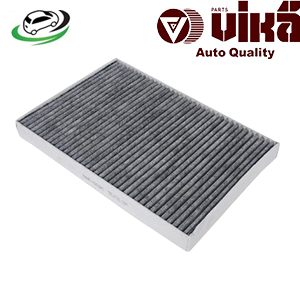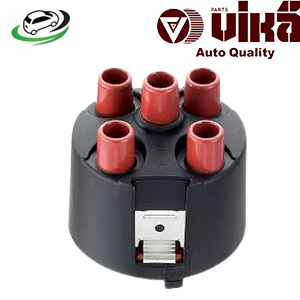-27%
Get VW Fox/ Jetta GLI/ Golf GL/GTI Distributor Cap 027905207A
The distributor cap is a critical component in older automotive ignition systems, playing an integral role in the process of delivering the electrical spark needed to ignite the air-fuel mixture in the engine’s cylinders. Although many modern vehicles now use distributor-less ignition systems, distributor caps remain essential in a variety of older cars and motorcycles. In this detailed exploration, we will discuss the functions, benefits, and maintenance of distributor caps, along with how they work within the ignition system.
1. What is a Distributor Cap?
The distributor cap is part of the ignition system, which is responsible for directing high-voltage electricity from the ignition coil to the correct spark plug at the precise time during the engine’s combustion cycle. The cap covers the top of the distributor, a mechanical device that rotates in sync with the engine’s camshaft.
The cap contains electrical contacts and terminals for each cylinder in the engine. These terminals correspond to each spark plug, and the cap also holds the central terminal connected to the ignition coil via a high-tension lead. Inside the distributor, a rotor spins and, as it rotates, connects the central terminal (receiving electricity from the coil) to each of the outer terminals in turn, sending a high-voltage current to the corresponding spark plug.
The primary purpose of the distributor cap is to house and protect the terminals and rotor while facilitating the proper distribution of electrical current from the ignition coil to the spark plugs. Without the distributor cap, the system would fail to deliver spark to the right cylinder at the right time, resulting in engine misfires, poor performance, or the engine not running at all.
2. Components of a Distributor Cap
To understand the workings of the distributor cap, it’s important to identify its key components:
- Cap Housing: The main body of the distributor cap is typically made from hard plastic to insulate and protect the electrical components from dirt, moisture, and mechanical damage.
- Terminals: Located inside the cap, these are the contact points for each spark plug wire. The number of terminals corresponds to the number of cylinders in the engine (e.g., a 4-cylinder engine has 4 terminals).
- Center Terminal: This is the connection point between the ignition coil and the distributor cap. The rotor inside the distributor makes contact with this terminal as it spins, delivering the current to the individual spark plugs.
- Spark Plug Wires: These wires connect the terminals on the distributor cap to the corresponding spark plugs, transferring high-voltage current to ignite the air-fuel mixture in each cylinder.
3. Functions of the Distributor Cap
The distributor cap plays multiple roles within the ignition system, ensuring the engine runs smoothly and efficiently.
- Electrical Distribution: The most important function of the distributor cap is to ensure that the high-voltage electricity from the ignition coil is delivered to each spark plug at precisely the right moment. The cap organizes and directs this flow of electricity to the correct spark plug, timing it perfectly with the engine’s firing order.
- Spark Timing: Proper engine timing is crucial to maintaining performance, fuel efficiency, and preventing engine damage. The distributor cap works in conjunction with the rotor and distributor shaft to ensure that the electricity reaches the spark plugs exactly when the engine requires a spark, based on its rotation cycle.
- Protection from External Elements: Because the distributor cap is made of insulated material, it shields the distributor from external contaminants such as moisture, dirt, and oil. Any foreign substances inside the ignition system can lead to misfires, corrosion, or short circuits.
4. Benefits of a Distributor Cap
The distributor cap is crucial for the reliable operation of a vehicle’s engine, especially in older vehicles. Here are some of the key benefits of maintaining a properly functioning distributor cap:
- Engine Efficiency and Performance: A healthy distributor cap ensures that the engine receives the proper spark at the right time, optimizing the combustion process. When the air-fuel mixture is ignited in sync with the engine’s operation, the vehicle runs more smoothly, with better fuel economy and performance.
- Reduced Misfires: One of the major causes of engine misfires in older vehicles is a faulty distributor cap. Regular inspection and replacement of the distributor cap ensure that each cylinder receives a spark, reducing the likelihood of misfires, stalling, or hesitation during acceleration.
- Cost-Effective Maintenance: Distributor caps are relatively inexpensive components, and replacing them as part of routine maintenance can help prevent more serious and costly issues, such as damage to the ignition coil, rotor, or other parts of the ignition system.
- Smooth Engine Start: A properly functioning distributor cap ensures smooth engine start-up by delivering the necessary spark to ignite the engine. When the distributor cap is worn or damaged, it can result in difficult engine starts, especially in cold weather.
5. Signs of a Faulty Distributor Cap
Over time, the distributor cap can become worn out or damaged, leading to performance issues. Here are some common symptoms that indicate the distributor cap may need to be inspected or replaced:
- Engine Misfires: Misfires are one of the most obvious signs of a faulty distributor cap. If the cap is cracked, corroded, or worn, it can disrupt the electrical flow, leading to inconsistent spark delivery to the spark plugs.
- Rough Idling or Stalling: If the distributor cap is not functioning properly, you may experience rough idling or sudden stalling. This occurs when the engine does not receive a consistent spark, leading to interruptions in the combustion process.
- Hard Starting: A damaged distributor cap can cause difficulty in starting the engine, especially when moisture or condensation is present. Water inside the cap can short-circuit the electrical flow, preventing the engine from firing up.
- Unusual Noises: If you hear popping, tapping, or clicking noises from the engine, it could be a sign of ignition issues caused by a bad distributor cap. This may happen when the spark delivery is erratic.
- Check Engine Light: In many cases, if the distributor cap is faulty, it will trigger the vehicle’s onboard diagnostics system, resulting in the “Check Engine” light appearing on the dashboard.
6. Maintenance and Replacement of Distributor Caps
Routine inspection and maintenance of the distributor cap are essential for keeping the ignition system in good working condition. Here’s how to maintain and replace the distributor cap:
Inspection of the Distributor Cap
- Visual Inspection: Regularly check the condition of the distributor cap for signs of wear, cracks, corrosion, or carbon deposits. Examine the cap’s internal contacts to ensure they are free from buildup or pitting.
- Check for Moisture: Since moisture inside the distributor cap can cause misfires, check for condensation or water intrusion. If moisture is present, dry the cap thoroughly and consider replacing it if the seal is compromised.
- Examine the Rotor: When inspecting the distributor cap, also check the rotor inside the distributor. If the rotor shows signs of wear or corrosion, replace it along with the cap.
When to Replace the Distributor Cap
The general recommendation is to replace the distributor cap every 30,000 miles (48,000 kilometers) or as indicated in the vehicle’s maintenance schedule. However, if the vehicle exhibits any of the symptoms mentioned earlier (such as misfires or difficulty starting), the distributor cap should be checked and replaced if necessary.
How to Replace a Distributor Cap
Replacing the distributor cap is a relatively straightforward process that can be completed in a few simple steps:
- Locate the Distributor: The distributor is typically located near the engine, with the cap sitting on top of the distributor body. Consult the vehicle’s manual if you are unsure of the location.
- Remove the Spark Plug Wires: Before removing the cap, carefully note the arrangement of the spark plug wires to avoid confusion when reattaching them later. Label the wires or take a photo for reference.
- Remove the Distributor Cap: Depending on the vehicle, the distributor cap may be secured with screws, clips, or bolts. Remove these fasteners to lift the cap off the distributor.
- Install the New Cap: Align the new distributor cap with the distributor body and secure it using the screws or clips. Ensure the cap fits snugly and evenly.
- Reconnect the Spark Plug Wires: Reattach the spark plug wires to the appropriate terminals on the new distributor cap. Make sure they are connected securely and in the correct order.
- Test the Engine: Start the engine and check for smooth operation. If the engine runs smoothly, the distributor cap replacement was successful.
7. Conclusion
The distributor cap is an essential component of the ignition system, ensuring that the engine receives the spark it needs to run efficiently. Regular maintenance and timely replacement of the distributor cap can prevent engine misfires, improve performance, and extend the lifespan of other ignition system components. By understanding the functions, benefits, and signs of wear in a distributor cap, vehicle owners can maintain their engines in top condition, even in older cars that rely on this traditional ignition system.
Follow us on Facebook for more parts.




Reviews
Clear filtersThere are no reviews yet.